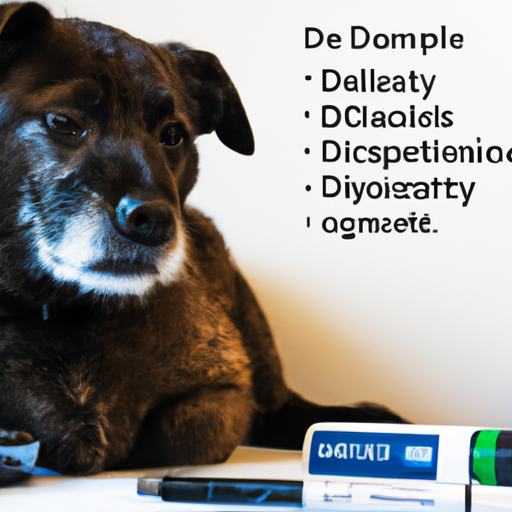As a caregiver to your beloved pet, understanding the signs of diabetes in dogs is crucial for your dog’s health and well-being. This guide will walk you through the symptoms to watch out for, risk factors, prevention strategies, and treatment options.
1. Understanding Diabetes in Dogs
Diabetes in dogs is a chronic disease that can have severe implications if left untreated. It’s a condition where the body can’t adequately produce or utilize insulin, a hormone necessary for converting food into energy. When your dog’s body can’t make enough insulin, sugar builds up in the bloodstream, leading to high blood sugar levels (hyperglycemia).
There are two types of diabetes that can affect dogs:
- Type I Diabetes: This is the most common form in dogs, where the body does not produce enough insulin. Dogs with this type of diabetes will require insulin injections for the rest of their lives.
- Type II Diabetes: This type is rare in dogs. It occurs when the body can’t utilize insulin properly. Weight management and oral medications can often manage it.
2. Signs and Symptoms of Diabetes in Dogs
Diabetes can present itself subtly in dogs, and symptoms may take time to become noticeable. As a responsible caregiver, you should be aware of these signs:
- Increased Urination: Dogs with diabetes tend to urinate more frequently. This happens because the body tries to get rid of excess sugar by flushing it out through urine.
- Excessive Thirst: Due to increased urination, your dog may become dehydrated and show an increased thirst.
- Weight Loss: Despite eating more than usual, your dog might start losing weight. This is due to the body’s inability to convert food into energy.
- Increased Hunger: As the body struggles to convert food into energy, your dog might experience an increase in appetite.
- Fatigue and Lethargy: If your dog seems unusually tired or lethargic, it could be a sign of high blood sugar levels.
- Cloudy Eyes: In advanced cases, dogs might develop cataracts, resulting in cloudy or foggy eyes.
| Common Symptoms | Description |
|---|---|
| Increased Urination | More frequent urination |
| Excessive Thirst | Increased water intake |
| Weight Loss | Despite eating more |
| Increased Hunger | Despite regular meals |
| Fatigue and Lethargy | Unusual tiredness |
| Cloudy Eyes | Cloudy or foggy appearance |
3. Risk Factors and Prevention
While any dog can develop diabetes, certain factors increase the risk, including obesity, age, breed, and gender. Females, older dogs, and certain breeds such as Miniature Schnauzers, Bichons Frises, and Poodles are more susceptible.
To prevent diabetes in dogs:
- Maintain a healthy diet for your dog, avoiding high-sugar foods.
- Regular exercise to keep your dog’s weight in check.
- Regular vet check-ups to detect any early signs of diabetes.
4. Treatment for Diabetes in Dogs
If your dog is diagnosed with diabetes, don’t despair. With the right care and treatment, your dog can lead a healthy, happy life. Treatment often includes:
- Regular insulin injections.
- Dietary adjustments, such as high-fiber diets.
- Regular exercise to maintain a healthy weight.
Regular vet visits are essential to monitor your dog’s health and adjust the treatment plan as necessary.
5. Frequently Asked Questions
Q: Can diabetes in dogs be cured?
A: Currently, there’s no cure for diabetes in dogs. However, with proper management, your dog can lead a healthy and normal life.
Q: How is diabetes diagnosed in dogs?
A: Diabetes in dogs is diagnosed through a series of tests, including blood tests and urinalysis, conducted by a veterinarian.
Q: Can diabetes in dogs lead to other health complications?
A: If left untreated, diabetes can lead to other health complications, including cataracts, urinary tract infections, and kidney disease.
Q: How often should I take my dog for check-ups if it has diabetes?
A: Regular check-ups are crucial. Your vet will recommend a schedule based on your dog’s health condition.
Remember, as a caregiver, your awareness and proactive management can make a significant difference to your pet’s health. Stay observant, and always consult a vet if you notice any signs of diabetes in your dog.



